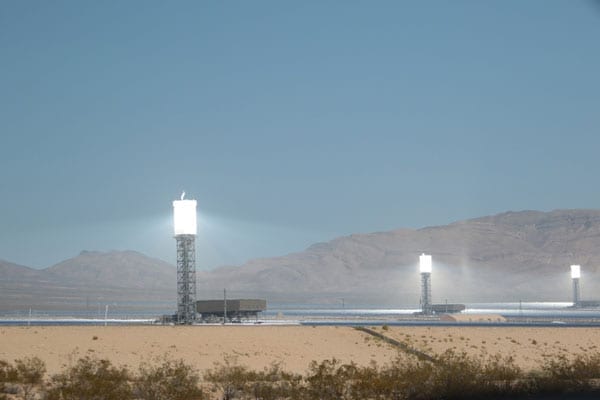Concentrated Solar Power Plant Types
April 17, 2017
What Is Concentrated Solar Power?
Converting the Sun’s heat energy into usable electric energy makes up a growing portion of solar power plants. These plants called solar thermal plants, or concentrated solar power plants, reflect heat from a wide area onto a single line or point and use movable reflectors to track the sun’s movement and maximize efficiency. The heat is absorbed into a carrier fluid and accumulated to power a heat engine for electricity generation.
Concentration is Key
The thermal energy of the Sun is low when diffused over the surface of the Earth, but when concentrated, it can reach very high temperatures. Smaller plants that reach lower temperatures can use water as the carrier fluid to run a steam engine. Plants that reach higher temperatures can use carrier fluids such as oil or even molten salt to capture and hold the energy until the heat can be transferred into water to run a conventional steam engine.
Variations Of CSP Plant Types
Reflector Types
The different types of concentrated solar thermal power (CSP) plants vary primarily on the type of reflector controls used to track the Sun for energy capture optimization. The simpler version uses single-axis tracking, while a more complex version tracks the Sun on two axes. When only one axis is used, heat is reflected from multiple surfaces onto a single line of carrying fluid. The most common example is a parabolic trough, which has been used extensively for solar thermal energy capture.
Modern versions of single axis tracking use a linear Fresnel reflector that is comprised of rows of flat mirrors. Fresnel reflectors can also use a fixed receiving fluid instead of a mobile flowing one, as used in parabolic troughs, making them more efficient in footprint. Additionally, since each reflector is flat instead of curved, linear Fresnel reflectors are cheaper to construct than parabolic troughs.
Utilizing Multiple Axes
When both axes are used, called dual axis tracking or array tracking, reflectors concentrate heat onto a single point. Each reflector is computer controlled to precisely track the sun. The most common arrangement of a dual axis CSP plant is called the power tower, where an array of individually-controlled flat mirrors reflects heat onto a point raised above the ground. Altogether, power towers can operate more efficiently than parabolic troughs since they generate temperatures above 500°C, while troughs operate around 400°C.
Small-Scale Options
A smaller Scale version of array-tracked solar thermal power is the power dish array or dish-Stirling system, which fixes a receiver onto the focal point of individual parabolic dishes. While the receiver is fixed to the dish, it is considered a mobile receiver since the dish itself is moving to track the Sun. Since a common carrying fluid cannot be used efficiently in these cases, gas is used instead to run a Stirling engine. The kinetic energy generated within the Stirling engine is then harnessed as electricity. Dish-Stirling systems are efficient since they Scale nearly linearly per dish and also can utilize much hotter temperatures—around 700–800°C—due to the use of gas as the receiving medium.
The Biggest Concentrated Solar Power Plant Is In The U.S.
Higher Concentration In The West
In the United States, the majority of plants are located in California, Nevada, and Arizona—areas of the country with high levels of direct solar incidence, little cloud cover, and large areas of unused contiguous land. Parabolic troughs are still the most common solar thermal technology and are being used in new plant installations. While parabolic troughs are an older technology, they are tried and true with relative operational ease and the technology is a safe bet when high land use efficiency is not required.
 California – Home To The Biggest In The World
California – Home To The Biggest In The World
Of course, other technologies have been successfully used as well. In Bakersfield, CA, a plant built in 2008 uses Compact Linear Fresnel Reflector (CLFR) technology due to the reduced footprint needed. While only at 5 MW capacity, the plant is fully operational and also serves as a testing facility. The largest solar thermal facility in North America, and in the world, is the Ivanpah Solar Power Facility in San Bernardino, CA, which is a power tower plant that actually has three towers. However, the facility has had difficulty delivering its stated capacity, so despite the theoretical benefits of power towers over troughs, practical applications are still a hurdle.
Do Concentrated Solar Power Plants Have To Be In The Desert?
Contrary to popular thought, solar plants can also be useful in land areas further from the equator. In fact, Canada is the proud owner of a 1 MW solar thermal plant situated in Medicine Hat, Alberta. However, utility-Scale plants are definitely difficult with lower levels of insolation. In such areas, CSP technology is most useful for contributing clean power generation for small industry use.
About Scale Funding
Scale Funding is an invoice factoring company serving businesses across the United States. For more information on factoring, call (800) 707-4845 for a free, no-obligation consultation and quote.


